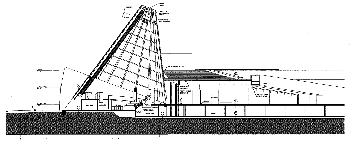|
Subscribe / Renew |
|
|
Contact Us |
|
| ► Subscribe to our Free Weekly Newsletter | |
| home | Welcome, sign in or click here to subscribe. | login |
1999 A&E Perspectives
|
|
Indoor weather makers
Designing flexible environments for interactive spacesBy SANDRA BONDERMANNotkin Engineering The new wave of visitor and cultural arts centers such as the International Glass Museum, Experience Music Project and the Pacific Northwest Aquarium are pushing the envelope of flexible mechanical design. Being comfortable in these new buildings means that heating, ventilation and air conditioning systems must be designed to meet the varied entertainment and interactive experiences promised by these facilities.
Industrial arts meets cultural artsThe International Glass Museum in Tacoma combines museum exhibit space with a "hot shop" glass blowing area and industrial stack to contain gases from 2600 to 2800 degree furnaces. "This is a complex building-out of the ordinary in terms of other museums. The Board of Trustees wanted the process of creating art to be integrated with the experience of viewing the finished piece of art," explains Wyn Bielaska, architect for Arthur Erickson/Nick Milkovich Architects in Vancouver, British Columbia. "It was also important to the artists that the audience would have an intimate experience and be able to feel the heat."
Designing the heating and cooling system for the International Glass Museum offers a few other challenges. Finding the right glazing system for an expansive window in the grand lobby will be important to controlling the temperature and ultraviolet rays and to accommodate sunlight changes throughout the day. The corrosive salt-water environment from the waterway on one side and contaminants from an adjacent highway on the other side also create special requirements for maintaining air quality and noise levels.
High-tech "edutainment"The Experience Music Project is moving ahead, and we're all set to be entertained by EMP's high-tech approach to offering a memorable music experience. The exhibit galleries, performance spaces and the multimedia "ride-like" experience of the Artist's Journey place special demands for optimum flexibility in heating, ventilation and air conditioning systems. Air temperature and ventilation systems are designed to quickly change based on occupant activities. With sensors detecting thermal differences in body heat, mechanical loads will be automatically fine-tuned to accommodate, for example, six teenagers who are rocking out in a jam session versus visitors walking through the Crossroads exhibits. For larger scale public projects, isolation of ambient noise is a key factor in design, and EMP will be a star example. Reliving a rock concert in Artist's Journey at EMP will not affect administrative staff in the suite below or in other areas of the facility.
Future of intelligent buildingsIn recent years, the tug-of-war has escalated between architectural goals and the need for enough room for the invisible infrastructure needed to support the building. Tom Ferlan, Notkin principal explains, "In the past, 10 percent of a building's space was typically allocated to house the building's ductwork, data lines, etc. With cooling loads increasing, engineers are now putting equipment and controls outside standard closets and mechanical rooms, and designing satellite spaces throughout the facility."
At EMP, some areas originally planned as exhibit space have been converted to closets to accommodate the additional audio/video, data communication and security systems, along with the mechanical systems to support the electronics. Squeezing fan coil units into ceilings also saves space. However, access to these small spaces by maintenance staff becomes harder and can increase maintenance costs. The benefit of decentralizing climate controls is greater flexibility to meet different space needs. At EMP, one of those needs is the demand for 24-hour operation in order to protect 80,000 artifacts. The life span of these artifacts is greatly affected by the capacity to control humidity, temperature and indoor air quality systems to very tight tolerances. For the International Glass Museum project, the latest in environmental building controls are being investigated-especially those with built-in Internet Web servers. For instance, an owner can reset building controls for a Seattle high-rise via the Internet on a laptop from anywhere in the world. Likewise, maintenance staff on site can view building layouts, alarms, and event logs directly on their Internet Web browser.The future of building automation also promises seamless integration of equipment. Gateways on the Internet enable control of building automation system from remote terminals. Costs for these integrated systems are becoming more reasonable. Even though initial costs are higher, owners are seeing that long-term upgrades will be cheaper, especially as they plan for longer building life spans. Although building automation systems were the stuff of science fiction only a few years ago, powerful network management architecture now allows mechanical systems to easily be fine-tuned and linked with other security, fire alarm, closed-circuit television and lighting systems. For example, fire suppression devices can extract information from security monitors sensors to identify occupied rooms in the event of a fire-a critical factor in large visitor facilities. Engineers can deliver integrated systems that will last well into the next millennium given the technology available today. Even though equipment and systems will change, owners can decide what their goals are over the long-term life of these exciting new landmarks. More than ever, building management systems have a touch of James Bond and Isaac Asimov. "Indoor weather makers," also known as mechanical engineers, are already planning for the next evolution.
Sandra Bonderman is a partner at Notkin Engineering and project manager for the Experience Music Project and International Glass Museum.
 djc home | top | special issues index
|


